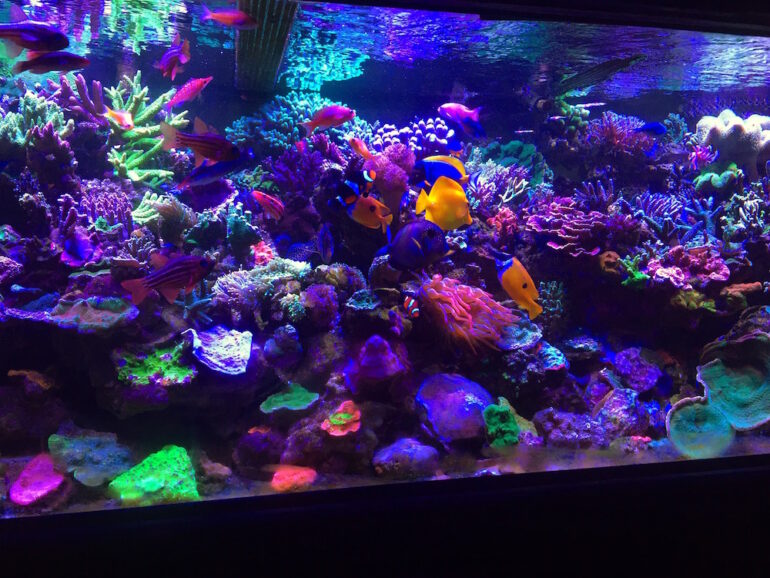Sand Bed or Bare Bottom?
In the aquarium hobby, one of the most significant debates when building your reef tank is to decide a bare bottom or to use a live sand bed. Let’s discuss the benefits and disadvantages of both.
Bare Bottom
You can siphon off detritus (dead organic matter like dead organisms or fish waste) that collects on the bottom of the tank. When you siphon, you’re exporting or removing excess nutrients such as ammonia, nitrates, and phosphates. We do not want ammonia in our reef tanks as it is deadly to our reef creatures. High levels of nitrates and phosphates will lessen coral growth and overall color.
 You can increase the flow by using strong currents to remove detritus and make it much less likely it will collect under a live rock. In time, the wastes move toward your mechanical filtration system and out of your system altogether. SPS corals will benefit from the increasing flow of your currents; if you did this with a sand bed, you’d create an underwater sand storm from your strong currents.
You can increase the flow by using strong currents to remove detritus and make it much less likely it will collect under a live rock. In time, the wastes move toward your mechanical filtration system and out of your system altogether. SPS corals will benefit from the increasing flow of your currents; if you did this with a sand bed, you’d create an underwater sand storm from your strong currents.
Sand Bed
We can discuss the advantages of using a sandbed with the largest one outside of your live rock; a sand bed acts as an additional biological filter and another home for good bacteria. Bacteria are responsible for the majority of filtration in your aquarium by removing and recycling excess nutrients by absorbing phosphates and ammonia that is found in fish and invertebrate waste.
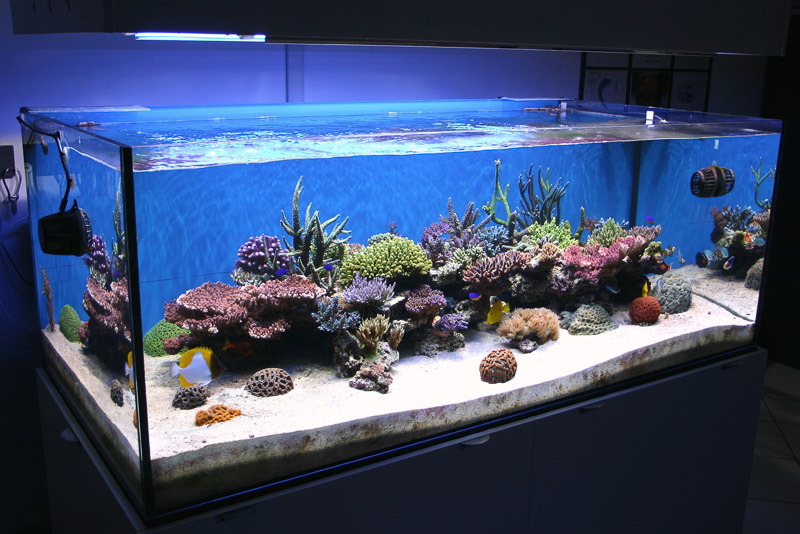
A sand bed also provides a food source for corals and other organisms in reef tanks. The sand bed clean up crew, consisting of organisms such as brittle worms, sea cucumbers, and snails, produce such things as eggs and larvae that find their way into the water column, acting as a food source for SPS and other filter-feeding corals.
Myth: Sandbeds are bad over time
According to Ron Shimek, a noted biologist who wrote a number of articles on deep sand beds, hydrogen sulfide will not migrate up out of the sand bed and poison the tank. He also believes that manual sifting is not necessary to control detritus accumulation. A good sand sifting crew will do the job.
What will you decide?
For the majority of reef builders the decision between a bare bottom and a sand bed tank is about aesthetics. In the Reef Builders Studio we run a variety of tanks and there is no good or bad way to build your reef tank except that you have fun and enjoy yourself.
For many reef keepers the choice between bare bottom versus a sand bed comes down to aesthetics. I like the look of a sand bed and have always kept shallow ones in my reef tanks. I also love to keep wrasses in my tanks, something that is not possible with a bare bottom.
While visiting Europe last Fall, I thought that most of the tanks I viewed looked for all intents and purposes like our tanks, I really did not notice many major differences overall or at least nothing that struck me as significantly different. The corals were big, colorful and very healthy in each of the tanks I saw, and aesthetically the tanks were all quite beautiful.
To be honest the biggest difference I noticed was that most of their corals were big colonies and very rarely did I see small frags being grown out in any of the display tanks. Technology wise they had a few new pieces of equipment that I had not seen before, but for the most part, these tanks would have fit right in with our tanks here.
Recently I had some of the friends I made there visit and I took them around to see some of the nicer tanks that I knew about. While they all said they loved the tanks they saw, especially how colorful our corals looked, but from their response, I knew that they felt that somehow these tanks were missing something. Only after really pressing them did they finally tell me what they were thinking.
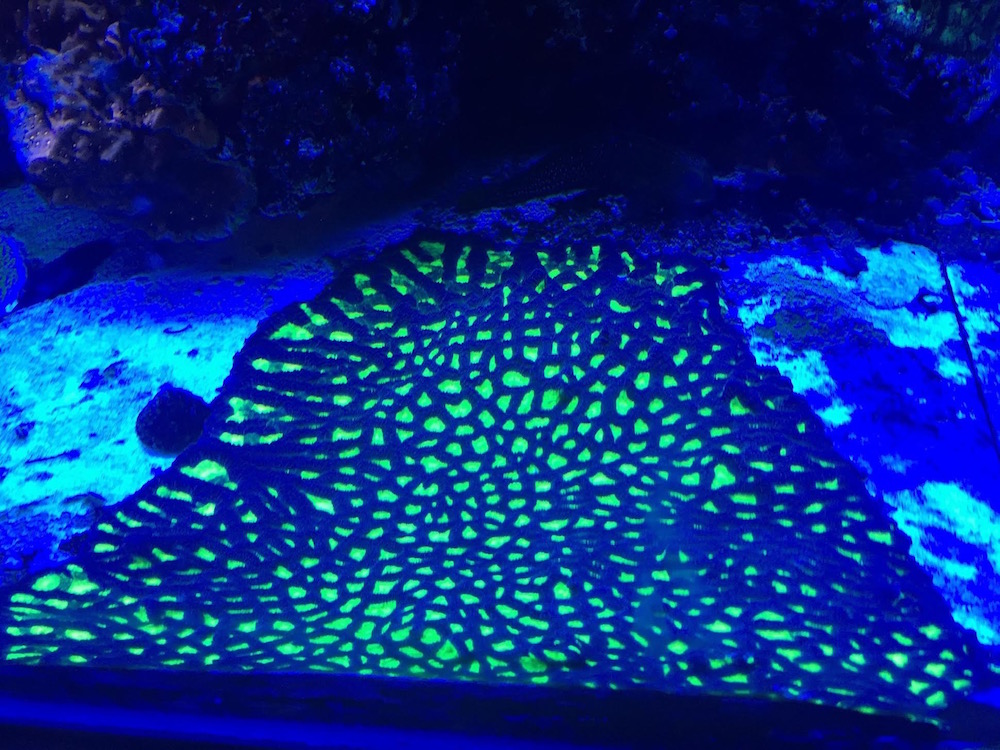
They all said the same thing: “The tanks are very beautiful, but where is the substrate?” Without thinking I had only taken them to see mainly tanks where the owners kept bare bottom tanks, which after thinking about it and looking at the pictures I took, that is indeed a major difference between how many of us keep our tanks compared with the European methodology.
Having kept both bare bottom and substrate filled tanks, including deep sand beds and substrate with plenums, I think I have a pretty good handle on the pros and cons of each. While I am not going to open the can of worms of the deep sand bed or which substrate to use, pun intended, I think this is still a topic to debate.
As I mentioned above, one of the aspects of the European tanks I saw that impressed me deeply was how aesthetically pleasing they were. As I look back and assess why I felt this way I realize it was not only the large coral colonies that were in these tanks and how well these tanks were incorporated into their surroundings, but it was also that each of the tanks I saw had substrate covering their bottoms.
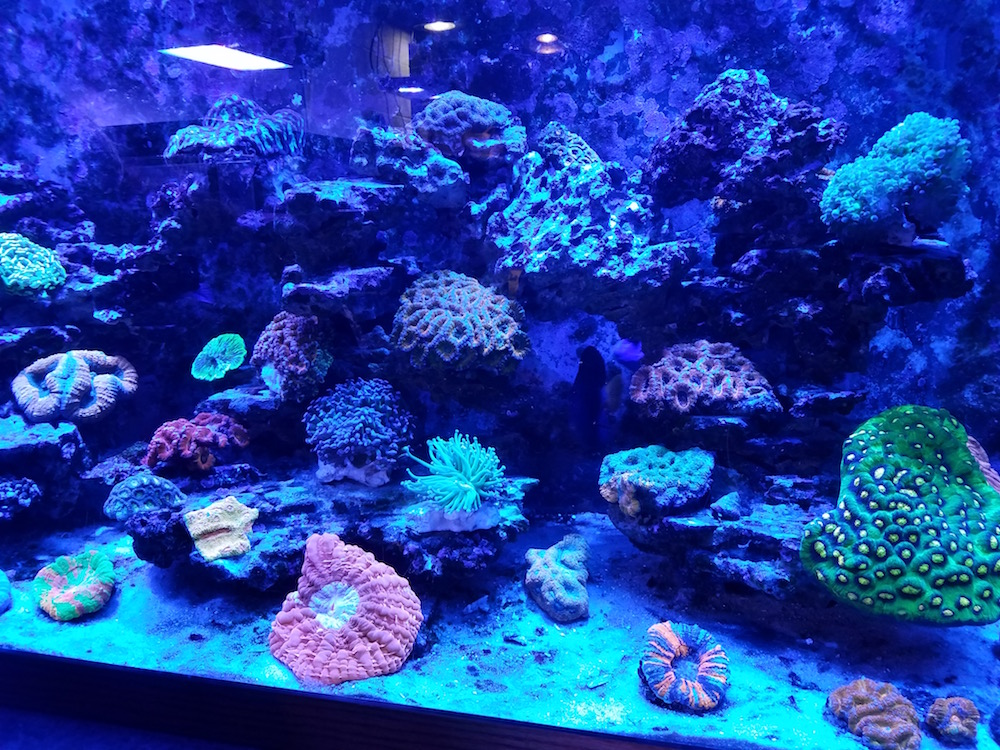
As much as I hate to admit it, as I run only bare bottom tanks now, having substrate did make these tanks look better. The closest tank I have seen to these are those of Julian Sprung and Sanjay Joshi, where like the Europeans large coral colonies above substrate make impressive displays.
But it is not just the substrate that makes all of these tanks look so good, but it is also what the substrate does in these tanks. First, the glitter lines moving across the substrate is more significant in these tanks than it is in a bare bottom tank. This is probably because the white substrate reflects the light far more than occurs in a bare bottom tank. This amount of reflected light may also result in some light being reflected up back under some of the colonies.
As a result of this reflected light, some of these corals may not get the same amount of bleaching on their undersides as occurs in some bare bottom tanks. I realize that a number of factors may account for this, but it is my observation that these factors all play into why a tank with substrate, at least to me, looks better than do most tanks with bare bottoms.
This is especially true if the tank is small or if a tank is aquascape with minimal live rock. In these instances, I feel that using substrate is almost essential not only from an aesthetic viewpoint but also in order to have adequate biological filtration.
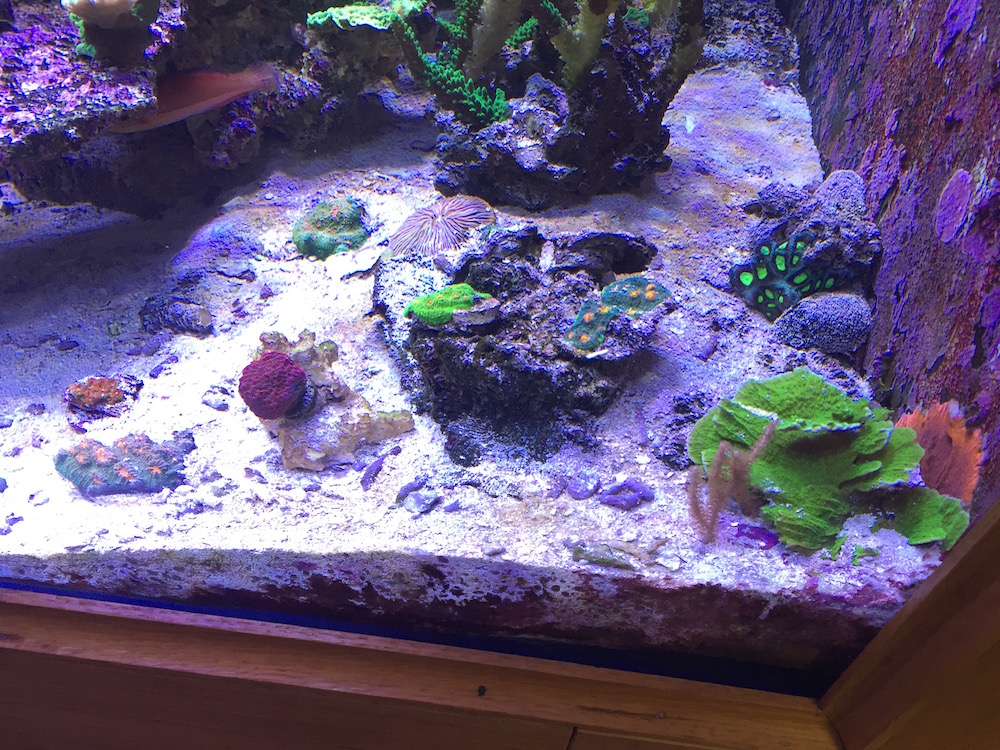
Since I have tried to emulate how the European tanks look when I set up my last tank, but still wanted the advantages of a bare bottom tank, I tried something different. In this tank I got a piece of black starboard that was cut to size and used it as the bottom of the tank instead of just bare glass. In this way, the bottom glass was protected and a dark substrate provided a nice contrast as opposed to white sand, gravel or plain glass.
I got this idea from Jason Fox, who’s tanks utilize this method. I also sealed the starboard onto the bottom and sealed the sides along the glass so that there are no spaces for detritus to accumulate. So far it has functioned like a bare bottom, but looks like there is substrate and coralline algae has grown over even faster than it has bare glass.
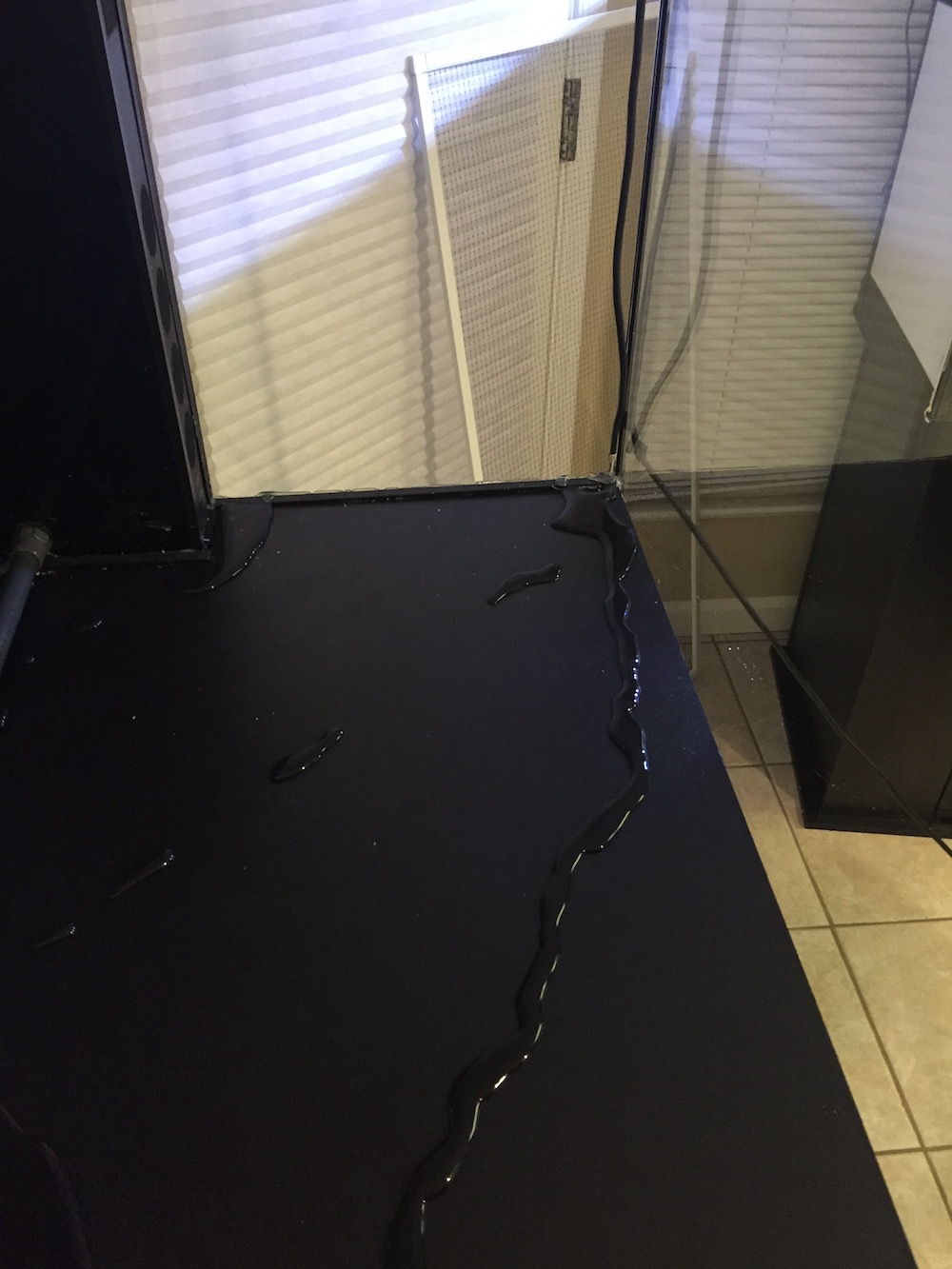
I have also seen a couple of tanks where the same result was achieved by “gluing” sand or gravel to the bottom glass. By doing this the look of substrate was achieved, but the benefits of a bare bottom was still present.
In addition to some aesthetics, there are also some other advantages to having substrate in a tank. First, having substrate dramatically increases the amount of surface area for bacteria to settle on. So theoretically this should provide for a tank to hold a greater biological load and also be able to more effectively or efficiently convert waste into less harmful compounds.
While this function may be taken up just as well with a well-functioning refugium, in a bare bottom tank, it is hard to know what the capacity of each is. In this regard more is better may indeed be the case, especially if you are like me and tend to overstock the tank with corals and especially fish.
Having substrate also allows for microfauna, like amphipods, copepods or other small crustaceans as well as worms, and burrowing mollusks to have a home. Having a healthy sand bed full of these organisms can go a long way in helping fish such a mandarins and scooter blennies to find enough natural food to survive.
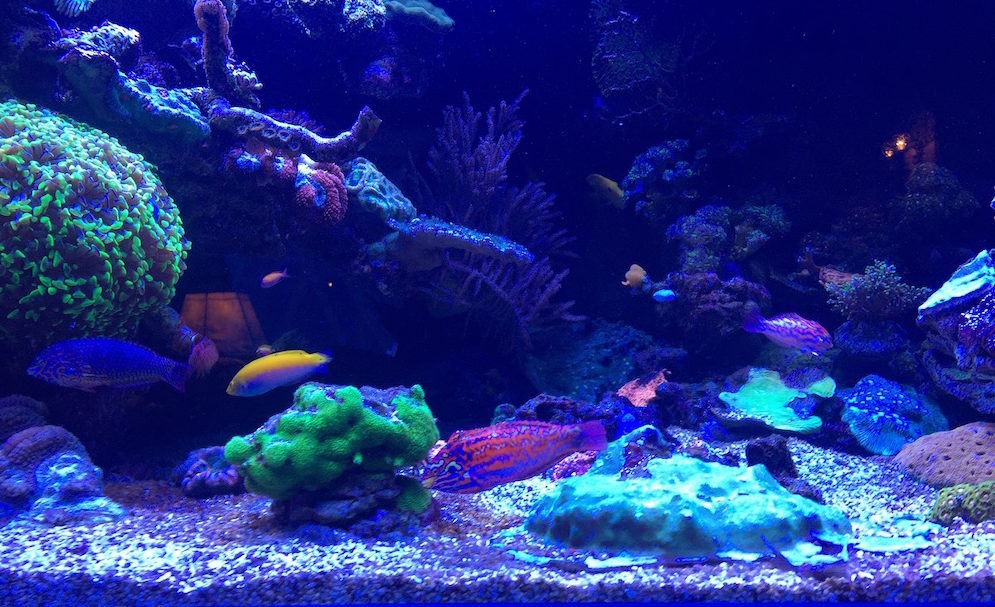
In addition, substrate is almost essential if one wishes to keep fish like burrowing wrasses, jawfish, sandsifting gobies or any of the small burrowing fish, alive for any length of time. Granted the type and size of substrate will need to vary depending on which of these fish you wish to keep, so this needs to be kept in mind as well. In addition to some fish needing substrate to thrive, some corals seem to do better when they rest on substrate than they do when they move around on bare bottom.
Plate corals like fungiids and diaseris as well as herpolitha corals all seem to prefer resting on substrate over the long term rather than bare glass. This may be due to their not liking to blow around seemingly randomly when no substrate is present. Substrate may also allow them to capture food more readily than in is the case when it blows by them as happens on glass when no substrate is present.
Lastly from a positive reason to use substrate, as I saw in some of the European tanks, using substrate is a good way to hide things like equipment or plumbing and make the tank look even more natural. For example, in the case of David Saxby’s tank, he used substrate to hide the glass troughs that were built into the bottom of his tank, which housed the many pipes he used to create the incredible flow he had throughout his tank.
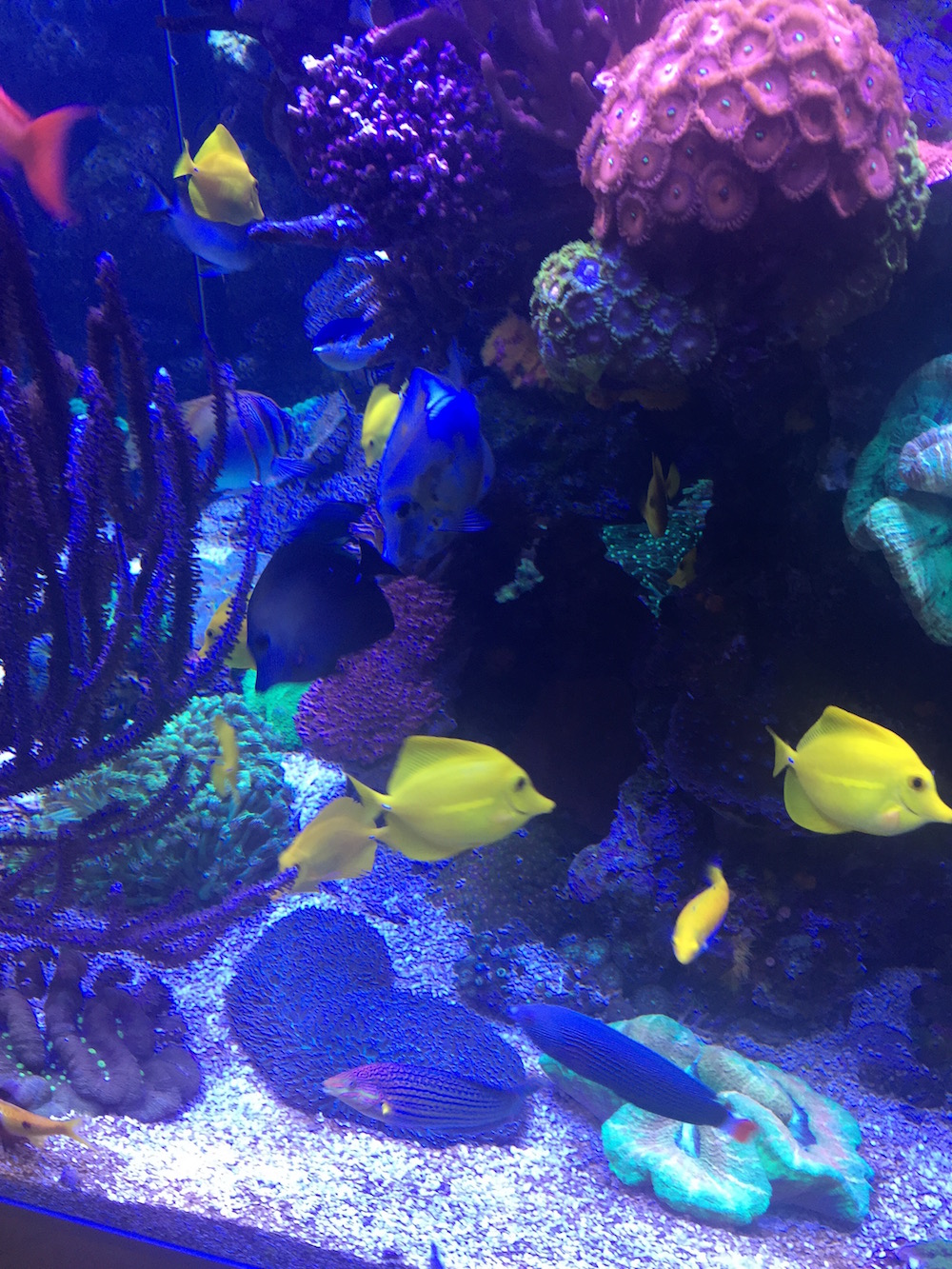
Similarly, Martin Lakin used it to not only hide things, but also to try and smooth the edges of his tank so that his tank looked even larger than it would have if the sharp edges of the tank and overflow boxes had been exposed.
Interestingly in both of these large tanks, a significant amount of the rockwork was attached directly to the side walls or sealed to the bottom so that little sand rested underneath the rock. This no doubt helped to keep the substrate clean in their tanks despite the heavy bioload and helped keep any “dead” spots from forming.
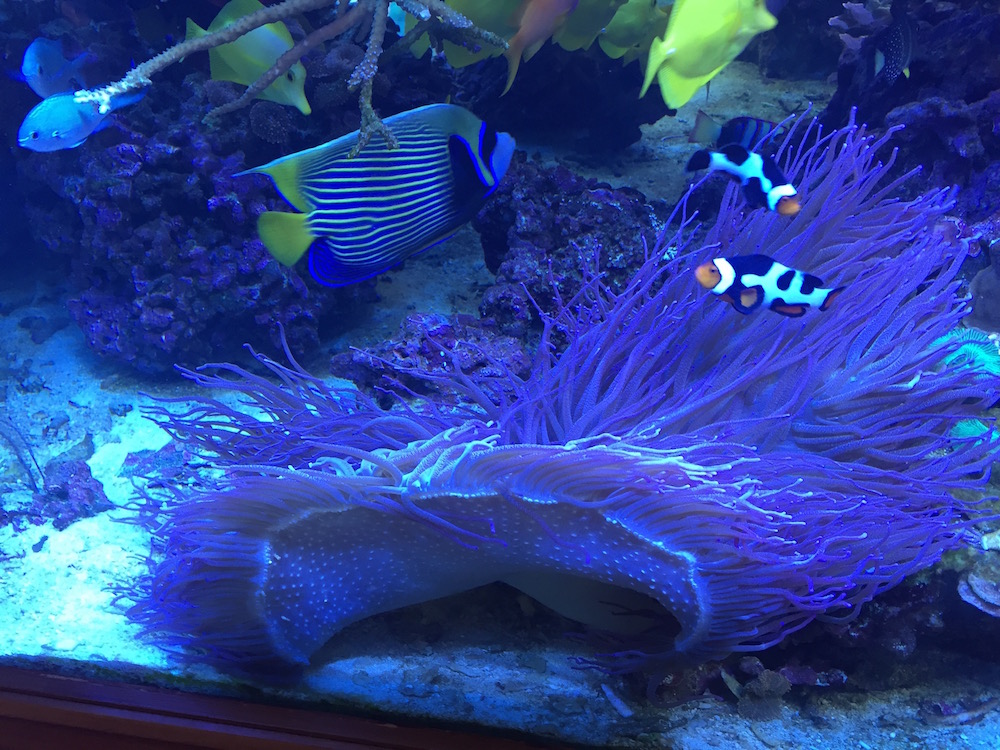
While there are indeed some positive aspects to having substrate on the bottom of a tank, there are also some negative aspects as well. And to those of us who keep bare bottom tanks, feel that these negative aspects outweigh the positive. To me, the single biggest reason why I no longer keep substrate in my tank is that it limits the amount of flow in my tanks.
In most of my tanks the flow within the tank is at least thirty times the tank’s volume. High flow is also used in most of the tanks I have seen housing sps corals where the goal is to maximize growth. Because of this high flow, it is almost impossible to keep the substrate from blowing around and acting like a sandblaster to the corals and fish in the tank.
I must point out though that Sanjay has kept his tank going for over ten years with substrate and much of the substrate in his tank is actually as old as the tank and was put in at its start. And he does this with the water movement in his tank being approximately sixty times the tank’s volume.
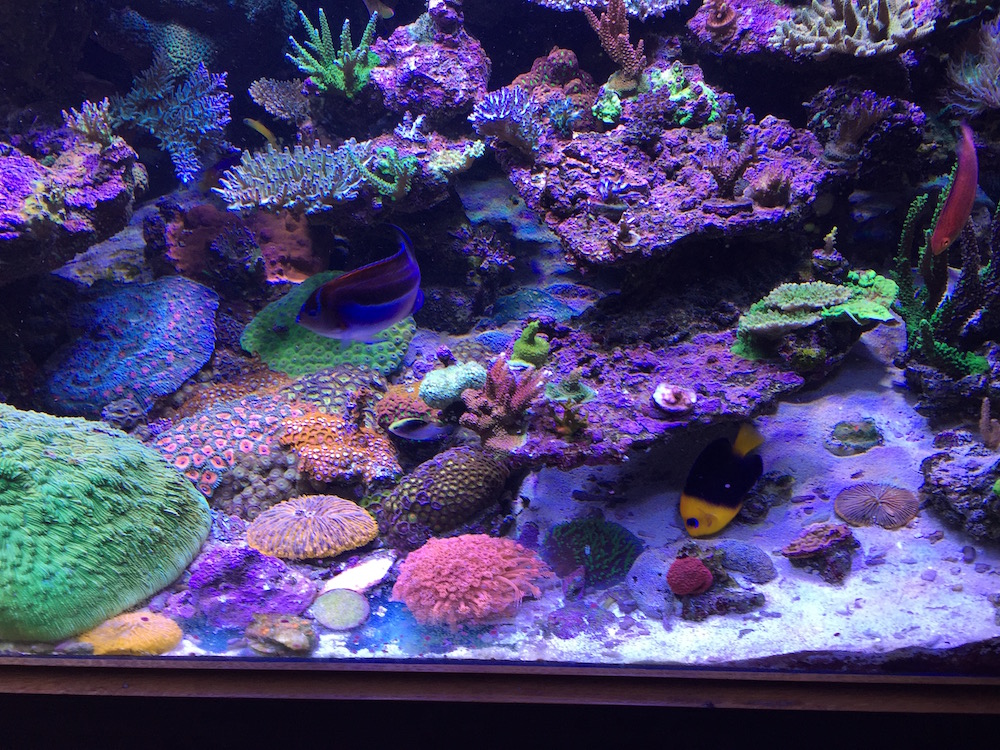
In some places in his tank the sand is high while in other spots it is quite low, with there even being some spots where the bottom glass is exposed, after all of these years, the substrate has pretty much settled into it in spots and does not blow around unless it is disturbed by Sanjay or one of the many fish the tank houses.
This leads to one of the other reasons why many of us prefer to keep bare bottom tanks over tanks with substrate: detritus and dirt tend to settle into the substrate over time and this gives the substrate the possibility of acting like a nutrient sink. I say this in that any time I have kept substrate over time it developed either a brown or grayish film and when it was stirred even a small amount it was sure to produce a cloud of dirt.
As a result, for many of us seeing this cloud of detritus coming from the detritus was a sure sign that “bad” things were occurring in the substrate. This also led to often heated discussions of whether the substrate should be regularly stirred up on not. Some felt that stirring up the substrate disrupted the natural processes that were occurring in it, while others felt that stirring it up during a water change was a good way to reduce the detritus and nutrients that accumulated in it.
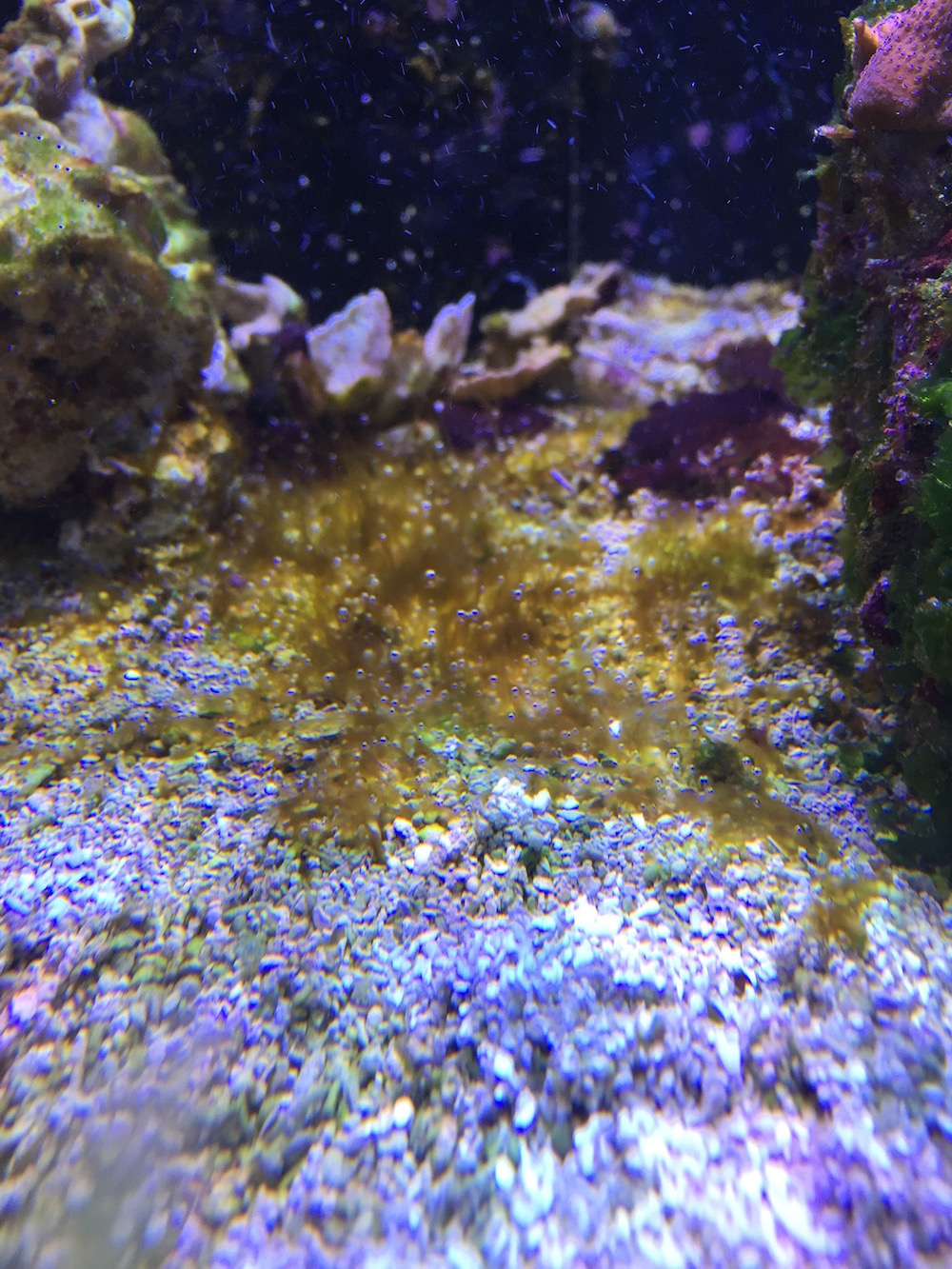
I tried it both ways and regardless of which I chose it seemed that over time the nutrient levels in my tanks, always tended to go up. I will admit that all of my tanks have always been overstocked by most estimates, so this probably contributed to the high nutrient levels. But since I have gone to bare bottom tanks with strong flow this problem has been reduced dramatically.
As mentioned above, some corals seem to do better when substrate is present, while this may be true, it is also possible to grow some corals on a bare bottom that would otherwise Encrusting corals like Montiporas, Cyphastreas, Favia, Porites and even star polyps all can be grown on a bare bottom.
In addition, coralline algae will also cover the bottom glass over time in a bare bottom tank. While initially a bare bottom tank may look stark compared with one having substrate, but over time if these corals are allowed to grow over the bottom they can provide colors and contrasts that a plain white substrate can’t.
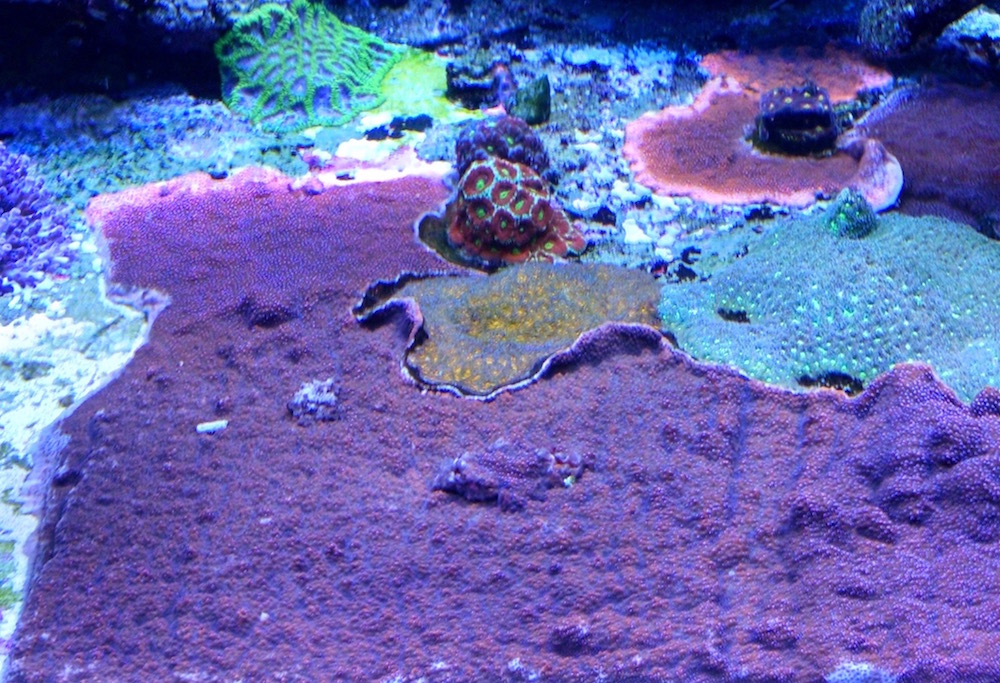
Another reason that I prefer a bare bottom tank that isn’t often considered is that over time the corals in my tank often become over grown. As a result, the rocks need to be moved and the overgrown corals need to cut back. When my tanks used substrate when these moves and changes needed to be made the result was often a major disruption owing to how much dirt and detritus was released when the bottom rocks were moved from the substrate.
Often after these moves it would take two to three months for the tank to settle back down and for everything to regain the health and vitality it had before the rocks were moved. Now these were not just the corals on the rocks, but rather all of the corals in the tank. So I can only surmise that this kind of disruption due to having substrate is not a good occurrence.
I say this as this has not been the case when I have had to perform the same procedure on a bare bottom tank. In fact, the opposite is true as everything seems to do better when things are thinned out and any detritus that has accumulated under the live rock has been removed.
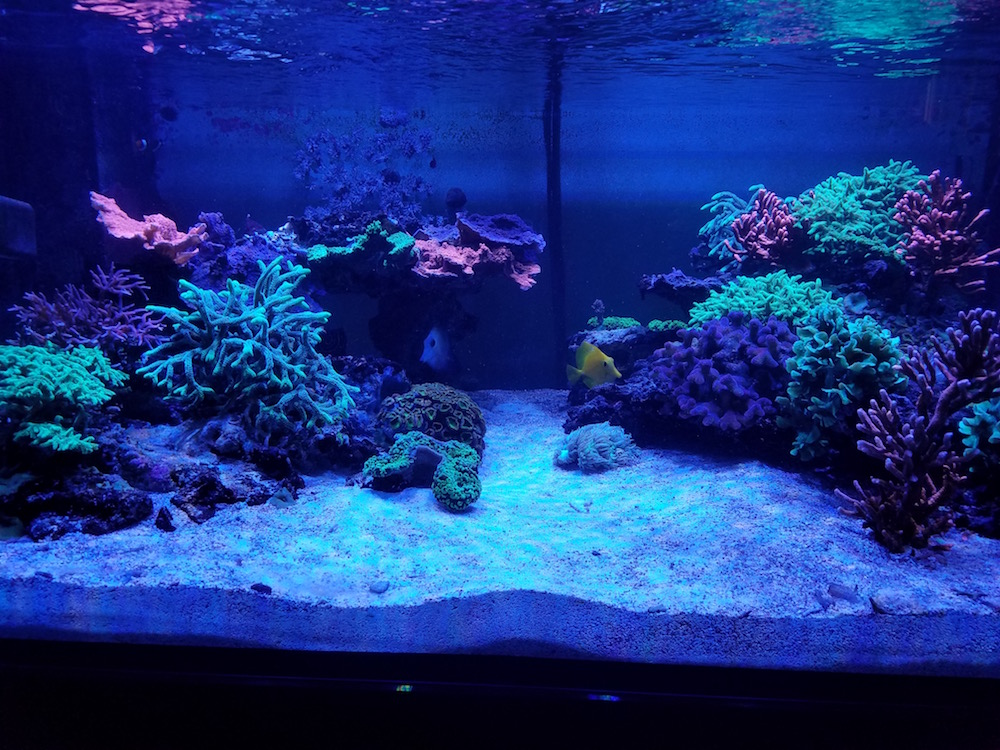
As with just about every aspect of the hobby there are multiple ways to do everything and whether to have substrate or run a bare bottom tank is just another choice. While I admit that aesthetically a bare bottom tank may look better, I do not recall anyone noticing that my tanks did not have substrate when they looked at the corals and fish.
Running substrate in a tank goes back to the days when we ran undergravel filters for biological filtration and having a deep substrate was a necessary evil. Now that we utilize live rock and a refugium, having enough substrate for bacteria to colonize is no longer an issue. As a result, when you decide which way you want to go there are a number of ways you can go.
I run bare bottom as a result of my desire to have as much flow as possible in my tanks, and using substrate limits how much flow I can use. But for those using less flow or who still like the look of what substrate brings this is still a great ay to go. Just as some like blue lights while others like white, there is no one way that works for everyone. As with most things in this hobby, do what brings you the most enjoyment.



